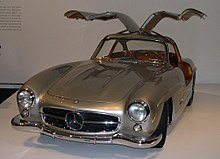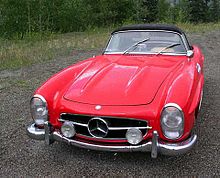New York Mercedes distributor Max Hoffman, Daimler-Benz's official importer in the USA, suggested to DBAG management in Stuttgart that a street version of the 300SL would be a commercial success, especially in America.
The racing W194 300SL was built around a tubular chassis to offset its relatively underpowered carbureted engine. Designed by DBAG's chief developing engineer, Rudolf Uhlenhaut the metal skeleton saved weight while still providing a high level of strength. Its unique architecture gave birth to the model's distinctive gull wing doors, as part of the chassis passed through what would be the lower half of a standard door. Even with the upward opening doors, the 300SL had an unusually high sill, making entry and exit from the car's cockpit problematic. A steering wheel with a tilt-away column was added to improve driver access.
The 300SL's body was mainly steel, except for the aluminum hood, doors and trunk lid. It could also be ordered with an all-aluminium outer skin at tremendous added cost, saving 80 kg (176 lb).
More than 80% of the vehicle's total production of approximately 1400 units were sold in the US, making the Gull wing the first Mercedes-Benz which sold in bulk outside its home market and confirming the validity of Hoffman's suggestion. The 300SL is credited for changing the company's image in America from a manufacturer of solid, but staid, automobiles to that of a producer of sporty cars.

The 300SL's engine, canted at a fifty-degree angle to the left to allow for a lower hoodline, was the same 3.0 liter straight 6 as the regular four-door 300. Fitted with a Bosch mechanical Gasoline direct injection system it had almost double the power of the original 86 kW (115 hp) carbureted version.
While not the first fuel-injected car - Mercedes engineers who had developed the principle for the DB 601 fighter aircraft engine had used fuel injection in the tiny 2-stroke Gutbrod they had designed after the War - it was the first to inject fuel directly into the cylinders. This innovation allowed a top speed of up to 260 km/h (161 mph) depending on gear ratio and drag, making the 300SL the fastest production car of its time.
The engine's maintenance requirements were high. Unlike the current electrically powered fuel injection systems, the mechanical fuel pump would continue to inject gasoline into the engine during the interval between shutting off the ignition and the engine's coming to a stop; this gasoline was of course not burned, and washed the oil from the cylinder walls and ended up diluting the engine's lubricating oil, particularly if the engine was not driven hard enough nor long enough to reach a temperature high enough to evaporate it out of the oil.
Exacerbating the problem were the large oil cooler as well as the large volume of oil (10 liters), both oriented more to racing than to street driving, which virtually guaranteed that the oil would not reach a high enough temperature. In practice, many street drivers would block off airflow through the oil cooler, and the recommended oil change interval was 1,000 miles (1,600 km). Operation of the clutch was initially very heavy, later roadsters having an improved clutch arm helper spring which reduced the pedal force. From March 1963 to the end of production, a light alloy crankcase was used on a total of 209 vehicles.[2]
Aerodynamics played an important role in the car's speed, Mercedes-Benz engineers even placing horizontal "eyebrows" over the wheel openings to reduce drag. Unlike many cars of the 1950s, the steering was relatively precise and the four-wheel independent suspension allowed for a reasonably comfortable ride and markedly better overall handling. However, the rear swing axle, jointed only at the differential, not at the wheels themselves, could be treacherous at high speeds or on imperfect roads due to extreme changes in camber. The enormous fuel tank capacity caused a considerable difference in handling depending on the quantity of fuel on board.









4 comments:
Mercedes is obviously my favorite car. Love your collection of Mercedes. Thanks for sharing the pictures. The collection is unique and different. I always enjoy reading your posts.
All Cars Buyers as it offers the most ideal approach to sell your unwanted auto, truck, van, SUV, 4×4, ute or Jeep. You call us, and we’ll give you a money offer you can’t refuse.
Call: 0403331443
Visit: cash for cars brisbane
This article really helped me a lot. Thanks for sharing this blog.
Sneed Speed | Racing Shift Knobs
Classic cars like the M-B 300 SL have a timeless appeal! 🚘✨
Keeping your car looking pristine is just as important as owning it.
For those needing professional rim maintenance, iTyreCare in Dubai offers expert services.
Check it out here: Rim Polishing Near Me.
Post a Comment